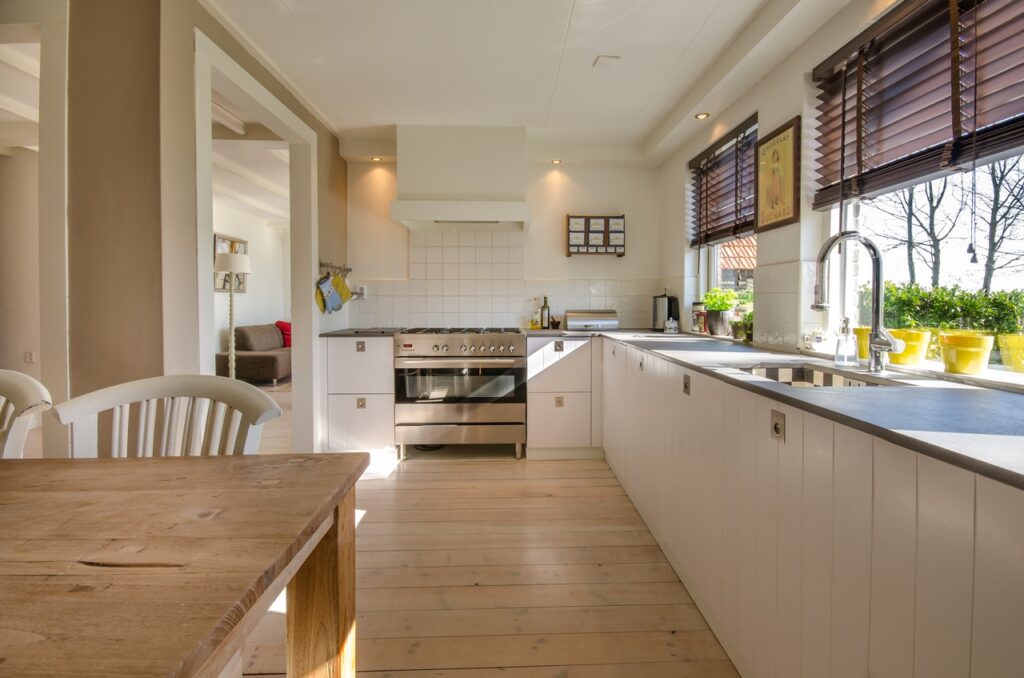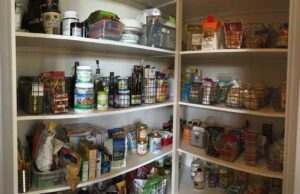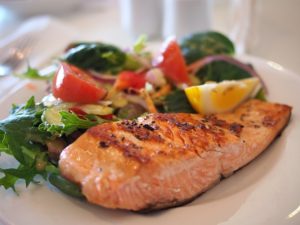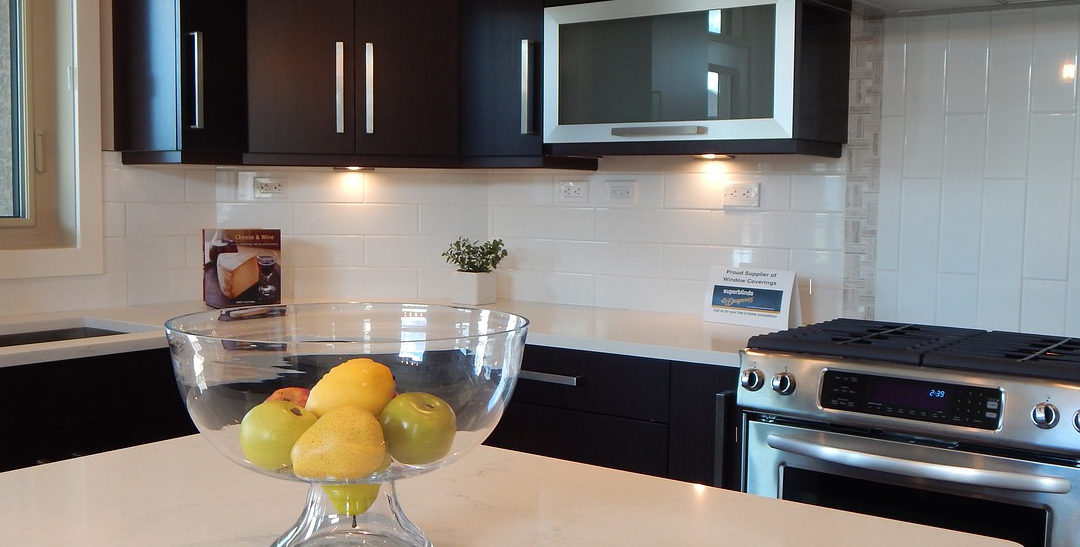by Jayme | Feb 8, 2022 | Clutter, Cooking & Kitchen, Eating & Kitchen, Organizing
 The new year is in full swing. Healthy eating and conscious kitchen choices are likely some of your new year’s goals. This month, we offer ideas on the 14 best areas to focus for decluttering and organizing your kitchen. Every day or two this month, declutter and organize your kitchen by breaking it down into small categories. You will feel a revised focus on your healthy eating goals.
The new year is in full swing. Healthy eating and conscious kitchen choices are likely some of your new year’s goals. This month, we offer ideas on the 14 best areas to focus for decluttering and organizing your kitchen. Every day or two this month, declutter and organize your kitchen by breaking it down into small categories. You will feel a revised focus on your healthy eating goals.
1. Baking dishes
Gather, sort, and evaluate all your dishes intended for baking. Simplify your inventory to the most practical items. Replace items that have lost their non-stick finish, are starting to rust, are starting to warp, or are only used on rare occasions.
2. Seasonings and spices
Pull out all seasonings and spices. Purge those that are expired, lack aromatics, are hard, or will not be used. Inventory what you have in writing, and make a list of what you need to replenish.
3. Coffee mugs
Mugs can consume a large amount of real estate in a kitchen. Consider the number of people in your home that use mugs and how often they are used. Simplify the quantity of mugs to what is practical in your kitchen.
4. Water bottles
Water bottles also take up a lot of space in a kitchen. Limit the quantity of water bottles to the number of people in your house. Bottles that require handwashing, have difficult spouts, tend to leak, or are not popular should be purged.
5. Freezer
Dig deep, inventory your kitchen freezer and deep freezer. Purge items that are old, smelly and show freezer burn. Meal plan around the freezer food you keep to reduce inventory and save money.
6. Formal entertaining dishes
Realistically examine the formal dining and service dishes you need to have on hand. Keep a practical set for a typical gathering. Reconsider if you need specific dishes for a specific holiday.
7. Bar glasses
A general set of tumblers, wine glasses, and pint glasses work well for most cocktails. Ditch the narrowly defined glasses that take up room in your cabinet.
8. Glasses
Reduce your daily glassware to what you use in a day. Every souvenir glass you have collected during your life likely doesn’t fit in your kitchen. Stick to the drinking glasses that are practical for your household and lifestyle.
9. Storage containers
Storage containers have a history of reproducing while you are not looking, and then ditching their partnering lid or base. Gather all storage containers, match up sets, and remove the misfits. Storage containers also take up a large area in your kitchen, so it is important to keep them under control.
10. Specialty gadgets
Avocado slicers’ and pepper storage containers might be fun gift items. But these specific, specialty items that are rarely used take up a lot of space. Consider more multiuse gadgets that are practical and don’t use up your precious kitchen space.
11. Small appliances
So many appliances for so many creative kitchen uses are available. The ideas are unlimited. Small appliances can be economical and practical if they serve more than one purpose and are used more often than once per year.
12. Disposable dishes and flatware
Disposable dishes and flatware from takeout and past parties may be taking over a cabinet in your kitchen. Gather all these items and intentionally plan to use them up. The kids will love having their breakfast on some cute happy birthday plates.
13. Snacks
The pantry likely has a collection of opened bags of snacks and crackers, and an inventory of candy from the past holiday. Get all of the snacks and candy together. Purge those that are stale, old, and completely unhealthy. Use up any opened snacks for your next family movie night. Keep the candy on hand for special treats and rewards for good behavior (if you decided to keep any).
14. Condiments
Condiment packets from school lunches and take out may be filling a drawer in your kitchen. Reduce the amount of condiment packets. Gather them all together, throw out any old condiments, keep a small selection of condiments you would use, and donate all the extras to a food pantry.
Now it is time to get started!
Take this month to work through your kitchen and remove the stuff that doesn’t meet your needs and takes up your limited kitchen space. Take the project category by category. It will keep you focused and it doesn’t require a large block of time.
If organizing your kitchen is overwhelming, Top Shelf Home Organizing would love to help. Contact Jayme for more inspiration.
by Jayme | Aug 23, 2021 | Cooking & Kitchen, Organizing
An organized kitchen is our hopes and dreams for preparing meals efficiently. Setting up the framework of your kitchen can help you be the best chef or short order cook you can be. Here are some tips from the organizing experts.
 Kitchen Items Only
Kitchen Items Only
Your kitchen is prime real estate when it comes to your home. You need to protect the boundaries and only allow kitchen items in the kitchen. The drawers labeled, “office,” “toolbox,” “junk,” or “crafts” can serve a new purpose in your kitchen. Place those items in their respective areas of your home; the office, the workshop/basement/garage, the trash or the craft room. This extra space will be a functional space in your kitchen.
Location
Where your items are located will determine how quickly and efficiently you can move around your kitchen. Everyday plates, glasses and flatware located near the sink or dishwasher will make putting dishes away streamlined. Occasional dishes and glasses can be located on the perimeter. Items that are only used annually or for very special occasions can be placed in a storage area in the basement or garage if space in your kitchen is limited. Small appliances that don’t get used can be donated. Those items take up a lot of room.
Pantry
Whether your kitchen has an official pantry or not, keep food items together versus spread around your kitchen. It will help you keep an accurate inventory of what food you have. Stashing food randomly throughout your cabinets will cause you to lose track of what you have. Identify an area of your kitchen where you will keep food.
Minimize
Minimize the items you have in your kitchen. Duplicates of utensils, cookware, storage containers and small appliances will cause overcrowding in the limited space. Identify the most practical items and place the extras into storage or remove them from your inventory.
There is no doubt a kitchen is one of the most challenging spaces in a home to organize. Establishing a framework for your kitchen and keeping only kitchen items in the kitchen will help maximize your kitchen’s potential. It will also help you be as efficient as you can be. If creating an organized kitchen is overwhelming to you, Top Shelf Home Organizing can help. Contact Jayme to see how Top Shelf Home Organizing can help you.
by Jayme Radomski | Oct 10, 2019 | Cooking & Kitchen, Organizing, Pantry
 Autumn is a great time to clear out the pantry and make room for fall foods, baking supplies and entertainment planning items. A fresh pantry will reignite your love for cooking and give your kitchen a little refresh. Clearing out and inventorying the food in your pantry can help with your meal planning and grocery shopping. We have put together four simple, practical tips for getting your pantry organized this fall.
Autumn is a great time to clear out the pantry and make room for fall foods, baking supplies and entertainment planning items. A fresh pantry will reignite your love for cooking and give your kitchen a little refresh. Clearing out and inventorying the food in your pantry can help with your meal planning and grocery shopping. We have put together four simple, practical tips for getting your pantry organized this fall.
- Remove all food and other items from your pantry
You will also want to gather food you have stored in other areas of your home. While the pantry is empty, it’s a great time to thoroughly clean all surfaces for a fresh start. Ahead of this project, consider purchasing the food you typically keep on hand. This is an important part of allocating adequate space in your pantry.
- Sort and categorize your food
During this process, you can categorize the food on your kitchen countertops and dining room table. Remove and dispose of expired food. Relocate nonfood items, especially if your pantry space is limited to another storage area of your kitchen or home. Categorize your food into snacks, canned goods, grains, pastas, nuts & seeds, etc.Strategize where food will go in your pantry based on the categories, quantity of food and convenience. You will want frequently used items within reach. Occasionally used items can go on higher, less convenient shelves. You may or may not want kids snack items within their reach.
- Purchase storage products
If you need them, explore and purchase storage containers that will work well for your pantry. Clear bins work great for corralling snack bars, chips and items that come in soft packaging. If you tend to purchase bulk grains, nuts, etc., you may want to consider tight sealing, clear containers for storage of these items that do not come with their own packaging. Measure your space carefully prior to buying storage items, as you want them to fit well in the space they will be used.Also be careful not to overcomplicate containers. Many times, placing pre-packaged food into containers may be more work than needed. Consider food rotation when deciding on containers. You will want to make sure the older food gets used first. Coordinating containers can make the pantry aesthetically pleasing.I also suggest labels for all containers. This will help ensure everyone knows where to return food to the pantry. Adding pull out drawers and baskets are nice for deep shelves to make all items visible and accessible. You can utilize the pantry doors for storage of lightweight, narrow items.
- Return food to pantry
Returning food to the pantry is fun. This is where you get to utilize any new storage products, decide on the best location for the food, and label the bins and containers. Remember that food goes with food in the pantry. Non-food items go with non-food items, and may need to be stored in other areas. The slow cooker you use two times per year, the holiday candles, or kids craft supplies may not have a home in your pantry, especially if you are low on space. Limit food storage in other areas such as the hall closet, bathroom, garage, and basement unless necessary.
Bonus Step: Create a meal plan that utilizes the food you have in your pantry. This will save you cash on your next shopping trip.
Pantry organizing can be a fun and easy organizing project that is good to do with the season changes. For a kick start on organizing your pantry, see if Top Shelf Home Organizing can help you. Contact Jayme for advice. We love what a fresh pantry will do for you.
by Jayme Radomski | Oct 5, 2017 | Cooking & Kitchen, Eating & Kitchen
I am sure you have heard meal planning can help you eat healthy and stick to a budget. This is true, no matter your culture, eating habits or household size, having a plan will prevent you from last minute drive-thru lunches and take and bake pizza dinners. Although we all love a simple pizza dinner every once in a while.
 Here are a couple ideas to help you to get into the habit of planning your meals.
Here are a couple ideas to help you to get into the habit of planning your meals.
Planning Meal Ideas
Jot down meal ideas to last two weeks and keep a running list with you at all times. This can be a simple notepad or a meal plan app such as Mealime, Yummly or Foodprint.
For your meal planning, double recipes for freezer meals and leftovers, and leave room for dining out. Make sure not to over plan. Over planning can lead to food waste and possibly leave you feeling burnt out from too much time in the kitchen. Keep your meals simple, especially if you do not enjoy cooking or have a busy schedule. Consider a no cook or raw meal every once in a while. In our house, we do a meal of cubed cheese, cold meat, raw veggies, fresh fruit and whole grain crackers every couple weeks. The kids love it and it works well on a busy weeknight.
You can also try meal delivery services such as Blue Apron, Sun Basket, etc. it works well as a supplement to your planning. However, be sure the meals arrive on a good day for you to actually cook the food. The food will arrive fresh and need to be prepared within a day or two. In addition, check the portion options are sufficient for your family and will produce leftovers.
Planning a Meal Budget
Identify your food budget. Be sure to include a reasonable budget for dining out. Stick to your budget by eating seasonal produce, stocking up on meat when it is on sale or purchasing protein from a local meat supplier. In your meal plan, include a couple inexpensive, non-meat meals.
Eating healthier does not have to require spending more money. A local holistic health coach can guide you to planning healthier meals without breaking the budget. Better Health by Heather has helped our family eat healthier (our kids now get a serving of veggies in their breakfast smoothies without even knowing it!).
Planning for Shopping & Preparing
Plan a day to do your grocery shopping. Take your list to your local grocery store and try your best to stick to the list. You may also consider grocery delivery. Stores may add on a minimal fee for deliver, but the cost typically is made up in the time you would spend driving and shopping.
Identify a day for food preparation. This does not need to be an entire day; just a day that you can prepare fresh produce for weekday lunches and after work and school snacking. Although, doing both shopping and food preparation in the same day may leave you feeling frustrated and burned out. Try to keep these days separated.
Have fun planning your meals and enjoy watching your family eat better. There is no perfect plan. Don’t get frustrated by wasted food or too much time in the kitchen. Learn from your mistakes and tweak your plan to best fit your household.

by Jayme Radomski | May 14, 2016 | Cooking & Kitchen
Not Enough Kitchen Cabinets
Is your kitchen too small? You don’t have enough cabinets? Not enough counter space? Consider what is stored in your kitchen.
Make space in your kitchen
Reduce Items
- Reduce items to only kitchens items and only one of each item. One pizza cutter is enough. One set of measuring cups is enough. Limit serving platters to only what you need to host the largest party you have each year, dish towels to get you through until the next round of laundry.
- One set of dishes, no more than three plates per person living in your home. One set of flatware. No more than three cups per person.
Organize Items
- Group similar items and store them together. Plastic storage containers stored together. Stovetop cooking utensils stored together.
- Store items by use: items you use everyday in cabinets and drawers within reach. Occasional use items such as decorative serving platters on higher shelves, pots and pans stored together, near the stove. Plastic wrap, foil and bags near the refrigerator for storing leftovers and preparing lunches.
- See-through cabinets should be used to store visually pleasing items such as china. Keep these cabinets uncluttered.
- Cookbooks you use and love stored vertically on an open shelf or in a cabinet
- If storage space is very limited, consider hanging pots and pans, aprons and hot pads.
- For the pantry, sort food by category, toss old food and spices, consider see through containers for items that are loose and do not stack/stand well.
- Create wall space for to-do-lists, mail sorting and calendars
Storage Gadgets
- Invest in storage racks, containers and gadgets only when you have considered all the above.
- Purchasing storage items prior to reducing and reorganizing can prove to be a waste of money if not well though out. Lid racks, drawer dividers and in-cabinet organizers can be very useful with a good plan.
Organizing is a process, not a destination. A professional organizer can help you make the most of your kitchen space.
 The new year is in full swing. Healthy eating and conscious kitchen choices are likely some of your new year’s goals. This month, we offer ideas on the 14 best areas to focus for decluttering and organizing your kitchen. Every day or two this month, declutter and organize your kitchen by breaking it down into small categories. You will feel a revised focus on your healthy eating goals.
The new year is in full swing. Healthy eating and conscious kitchen choices are likely some of your new year’s goals. This month, we offer ideas on the 14 best areas to focus for decluttering and organizing your kitchen. Every day or two this month, declutter and organize your kitchen by breaking it down into small categories. You will feel a revised focus on your healthy eating goals.



